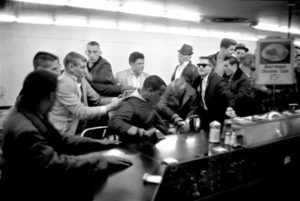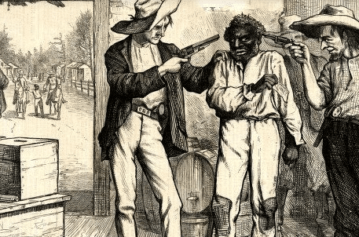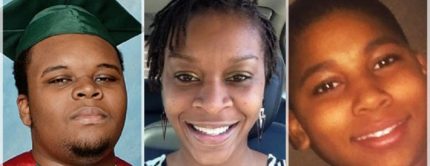
The arrest of two Black men who committed no crime at a Starbucks in Philadelphia is a reminder of the policies and practices throughout American history to control the activities of Black men (Photo: Flickr.com).
The arrest of two Black men in a Starbucks coffee shop in Philadelphia raises the issue of practices, policies and laws that have a discriminatory impact on Black people and target Black men in particular. Policies which monitor and restrict the movement of Black people require the active participation of people, whether police officers or baristas, who execute and make the system work. There is a long history in the United States of efforts to restrict the comings and goings of Black people and demarcate the breadth and scope of whites-only spaces and white privilege.
On April 12, two Black men were arrested for sitting down at a table at Starbucks as they waited for a friend. A coffee shop manager called the police after the men refused to make a purchase. After police arrived, the men refused to leave. They were arrested and released nearly nine hours later without being charged. Implicated in this incident are the role of implicit or unconscious bias, the decision by the store employee to call the police and the decision by the police to arrest them, and the possible role of the policies of Starbucks and the Philadelphia Police Department.
“Starbucks has issued an apology, but that is not enough. I have asked the Philadelphia Commission on Human Relations to examine the firm’s policies and procedures, including the extent of, or need for, implicit bias training for its employees. We are reaching out to Starbucks to begin a discussion about this,” said Philadelphia Mayor Jim Kenney in a statement, noting that the arrest “appears to exemplify what racial discrimination looks like in 2018.”
“Commissioner Ross and his team have promised a review of their policies moving forward with regards to response to complaints like this. I believe a thorough review is fully warranted given the unfortunate outcome of this event, particularly at a time when our criminal justice reform efforts are focused on avoiding needless incarcerations,” Kenney added. Ross, who called the incident unfortunate, defended the police, arguing the officers were professional and “did absolutely nothing wrong,” while also arguing the police did not want to arrest the men.
On May 29, Starbucks will close 8,000 stores to provide racial bias training to 175,000 employees.
Throughout the history of America, the movements of Black people were restricted through policies and practices and codified into law. Reflecting white paranoia and the fear by white settlers of slave rebellions with the increasing number of enslaved people, the colonies enacted slave codes to maintain the plantation police state and control Black people. As property, enslaved Black people were unable to own property, could not learn to read and write, were prohibited from assembling without a white person present, and subjected to special curfews when living off the plantation. With no legal rights, enslaved Black people could not leave the plantation without permission from the master, and were subjected to social control and laws that did not apply to whites.
The Virginia code, which served as a model for other jurisdictions, provided for the branding, whipping or maiming of slaves for minor offenses such as associating with whites. A 1680 law called for 20 lashes for any “negro or other slave” who would “depart from his master’s ground without a certificate from his master, mistress or overseer.” For major offenses such as robbery, the punishment was 60 lashes, with the enslaved person placed in stocks and his or her ears cut off. Those found guilty of murder or rape were hanged.
Under the South Carolina slave code of 1740, all “negroes, mulattoes, Indians and mestizos” were presumed to be slaves “unless the contrary can be made to appear.” Enslaved people could not travel without permission from their masters and faced execution for murder or attempting “to raise an insurrection.”
The slave codes provided for the slave patrols, which monitored the movements of the enslaved and were authorized to enter plantations without a warrant and search the premises. Southern white men were obligated to serve on the patrols, which stopped Black people they found on the road and forced them to produce a pass. These patrols were empowered to shoot any runaway slaves who refused to comply. Restricting where Black people could and could not congregate was a white community effort.
Not long after the Civil War came the black codes of the Jim Crow era, which were derived from the slave codes and made it illegal for Black people to assemble in public, whether during the day or at night. The goal was to control the newly emancipated Black people and maintain as much of the institution of slavery a possible, even to the extent of regulating their movement into and out of a particular state. Vagrancy laws provided for arrests and fines for Black men deemed idle, and turned them into convict laborers if they were unable to pay the fines. For example, part of the Mississippi 1865 vagrancy law read as follows:
Section 2. Be it further enacted, that all freedmen, free Negroes, and mulattoes in this state over the age of eighteen years found on the second Monday in January 1866, or thereafter, with no lawful employment or business, or found unlawfully assembling themselves together either in the day- or nighttime, and all white persons so assembling with freedmen, free Negroes, or mulattoes, or usually associating with freedmen, free Negroes, or mulattoes on terms of equality, or living in adultery or fornication with a freedwoman, free Negro, or mulatto, shall be deemed vagrants; and, on conviction thereof, shall be fined in the sum of not exceeding, in the case of a freedman, free Negro, or mulatto, $150, and a white man, $200, and imprisoned at the discretion of the court, the free Negro not exceeding ten days, and the white man not exceeding six months.
It was not until the nonviolent sit-in movement — including such notable civil rights figures as Rosa Parks and the Little Rock Nine, and the peaceful occupation of a segregated lunch counter in a Greensboro, North Carolina, Woolworth’s by four young Black men in 1960— that the Jim Crow laws allowing for segregated whites-only spaces began to come down. Participants in the sit-ins faced verbal assaults and violence from local white thugs. The movement spread to 55 cities in 13 states, with more than 50,000 students taking part, and led to the founding of the Student Nonviolent Coordinating Committee (SNCC).
The scenes nearly six decades ago of Black men sitting at a Greensboro lunch counter demanding to be served and being arrested for trespassing, disorderly conduct or disturbing the peace for refusing to leave resonate today in light of the recent Starbucks incident in Philadelphia. While the two incidents are not identical, both are examples of explicit and routine racial bias that invoke the disparate treatment of Black men and their white counterparts, and the dynamics of racial control in white-dominated spaces. The Greensboro Four challenged Woolworth’s official policy of refusing service to Black people, and occupied a whites-only space as a political statement to break down Jim Crow laws. Starbucks has no such policy of excluding Black people and has an African-American chief operating officer, although the manager who called the police has been accused of targeting Black customers for removal and discriminating against a Black employee.
The two Black men arrested in Starbucks apparently did not set out to make a political statement, although their demand to not be served has sparked protests and sit-ins in the very Starbucks where these men were arrested. Although they have not experienced the slave patrols and Jim Crow-era sit-ins of the past, the “Philly Two” faced racial discrimination because they attempted to claim the white privilege of sitting in the coffee shop without purchasing anything. This is something for which white people are not arrested, and an unwritten rule that does not apply to young Black men, who face arrest and even worse for doing nothing when someone calls the police.


